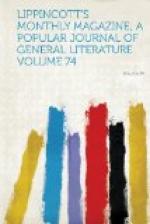On the 4th of May, 1535, Haughton was executed with all the horrors attending the punishment of death for high treason in those barbarous times. He and his companions, certain monks of Sion Priory, died without a murmur, and Haughton’s arm was hung up under the archway of the Charter-House beneath which the visitor drives to-day, to awe his brethren. The remnant never gave in. Some were executed; ten died of filth and fever in Newgate; and thus the noblest band of monks in the country was broken up by Henry’s ruthless hand.
The Charter-House was then granted to two men, by name Bridges and Hall, for their lives, after which it was bestowed in 1545 on Sir E. North. North’s son sold it to the duke of Norfolk, who resided there, on and off, until decapitated in 1572. The duke was beheaded by Elizabeth for intriguing with Mary queen of Scots, and the papers proving his offence are said to have been found concealed beneath the roof of the stately mansion he had erected for himself at the Charter-House.
Before the duke came to grief that most erratic of sovereigns was a visitor at his house—as indeed where was she not?—coming thence from Hampton Court in 1568, and remaining a day with him; and when her successor, James I., came to take up her English sceptre, he, mindful of what the Howards had suffered for their sympathy with his mother’s cause, came straight thither from Theobalds, his halting-place next to London, and remained on a visit of four days.
From the duke of Norfolk the Charter-House passed to his eldest son by his second wife, Lord Thomas Howard, who was created by James I. earl of Suffolk;[4] and he about 1609 sold it to Mr. Thomas Sutton.
Sutton’s career was remarkable. It was said of the late earl of Derby that even had he been born in a shepherd’s cot on Salisbury Plain, instead of in the purple at Knowsley, he would still have proved himself a remarkable man. In local phraseology, he was “bound to get on,” and so was Thomas Sutton. The son of a country gentleman at a place called Knaith in Lincolnshire, he inherited early in life a good property from his father, and spent some time in traveling abroad. Then he became attached to the household of the duke of Norfolk, probably as surveyor and manager of that great peer’s vast estates, and in 1569, when a serious disturbance broke out in the north of England, he repaired thither, and greatly distinguished himself in aiding to quell it. He then received the appointment of master-general of ordnance for the North for life.




